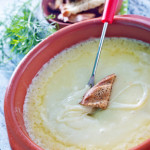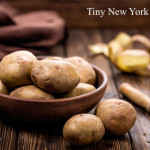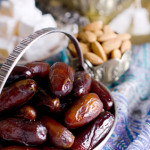I don’t know a single person who doesn’t love the taste of melted cheese. Not every cheese oozes the same way. Some just melt better than others. When it comes to classic cheesy dishes, you want a cheese that’s going to melt into something creamy and smooth with a strong flavor.
Basically, the more moisture in a cheese, the better it melts. Cheddars and Goudas with high moisture content can make for a nice fondue. Emmental, Challerhocker, Comté, and Gruyere are excellent for making fondue as well. These cheeses beg to be melted. Their smooth, dense texture and nutty flavor make them the top choice for classic fondue. Bread, pickles, crackers, meats, and charcuterie are perfect fondue pot divers.
Cheddars are, of course, excellent for making mac & cheese, grilled cheese, and cheeseburgers. I tend to go for sharp or extra sharp Cheddars because I like to really taste the tanginess.
Soft cow’s milk cheese like Brie and Camembert don’t take much time to get to that beautiful melted soft texture. Just put them in the oven for a few minutes and you’re good to go. Because they come in their own serving vessel you can dip whatever you like in there.
“Work With What You Got!”
© Victoria Hart Glavin Tiny New York Kitchen © 2017 All Rights Reserved
Figs are truly fantastic! Dried figs are available all year round and many markets offer luxuriously sweet fresh figs throughout the year as well. Figs are a healthy and portable snack that is packed with nutrition.
Figs are rich in potassium, which helps control blood pressure. They also provide calcium, magnesium, iron, and copper. Because they’re rich in fiber, figs support digestive health and may be helpful for managing a healthy weight. Figs are among the most alkaline foods and help balance the body’s pH.
Fresh figs are highly perishable, so they should be eaten a day or two after you purchase them. Look for figs that have a rich, deep color and are plump and tender, but not mushy. Wash them under cool water and remove the stem. Add fresh or dried figs to oatmeal, salads, cheese, and baked goods.
“Work With What You Got!”
© Victoria Hart Glavin Tiny New York Kitchen © 2017 All Rights Reserved
Generally animal products are higher in fat than plant foods, but it’s not necessary to cut out all meat and dairy products to keep your fat intake reasonable. Low-fat dairy foods, lean and well trimmed meat, and skinless poultry provide the same amounts of vitamins and minerals as their fattier counterparts. Skinless poultry, fish, dry beans, and split peas are the “slimmest” foods in this category. By removing the skin from poultry, you reduce the fat by almost one half. Most seafood is low in fat and also contains beneficial omega-3 oils, which have been linked to lowering blood cholesterol. Dry beans also provide the body with fiber, which is necessary for digestion.
You can enjoy red meat if you choose lean cuts and trim away all the visible fat (marbled fat cannot be trimmed away). Here are some good choices:
*Beef eye round, top round, tenderloin, top sirloin, flank steak, top loin, and ground beef. Choose ground sirloin; it’s 90 to 93 percent lean.
*Veal cutlets (from the leg) and loin chops.
*Pork tenderloin, boneless top loin roast, loin chops, and boneless sirloin chops.
*Lamb, boneless leg (shank portions), loin roast, loin chops, and leg cubes for kabobs.
Here are some suggestions to make trimming excess fat from your diet easier:
*Choose lean cuts of meat and trim off all the visible fat before cooking. Remove skin from poultry before or after cooking.
*Broil meat on a rack so the fat can drop away.
*Substitute ground chicken or ground turkey for ground beef. Look for ground turkey breast or chicken breast; otherwise, it may contain skin and therefore have as much fat as ground beef.
*Substitute protein-packed dried legumes, like beans and lentils, for meat in casseroles.
*Chill soups and stews overnight so you can remove all the hardened fat from the surface.
*Be skimpy with fat. Use nonstick pans and nonstick cooking spray, or sauté in a small amount of broth or water. Don’t just pour oil into a skillet; it’s easy to add too much. Measure or use a pastry brush to coat pans with a thin layer of oil. When baking, coat pans with a spritz of nonstick cooking spray instead of oils or fats. Kitchenware shops carry oil sprayers you can fill with your favorite oil.
*Experiment with low fat or skim milk, low fat sour cream and cheese, and nonfat yogurt. They provide the same amounts of calcium and protein as the whole milk varieties, but with less fat or none at all.
*When making dips, substitute nonfat plain yogurt for sour cream.
*Use fresh herbs and zesty seasonings literally.
*Choose angel food cake instead of pound cake, especially when making cake-based desserts like trifle.
*To reduce fat and cholesterol, you can substitute 2 egg whites for 1 whole egg in recipes, but don’t substitute egg whites for all the whole eggs when baking. The dessert will have better texture and flavor if you retain a cold or two.
*Replace sour cream with buttermilk or yogurt in recipes for baked goods.
“Work With What You Got!”
© Victoria Hart Glavin Tiny New York Kitchen © 2017 All Rights Reserved
Making precise slices of softer, smaller foods in a snap, literally, with this tool designed to hold slippery, hard-cooked eggs in its cradle as the wires cut through. Cleanup is just as speedy – use a kitchen brush and warm, soapy water.
It can quick slice soft fruits and vegetables such as peeled kiwis, hulled strawberries, white or cremini mushrooms, and pitted olives.
Create perfect rounds from soft cheeses, like fresh mozzarella balls and goat cheese.
Make even pats from a stick of butter.
Be creative and try using an egg slicer on soft foods that you’re preparing. The possibilities are endless.
“Work With What You Got!”
© Victoria Hart Glavin Tiny New York Kitchen © 2017 All Rights Reserved
5 Ways To Use A Vegetable Peeler
The humble vegetable peeler has hidden talents.
Easily Peel Fruit: To peel soft fruits and vegetables, like tomatoes and peaches, you usually have to briefly dunk them into boiling water. Using a good vegetable peeler is so much easier and faster. Look for peelers with serrated blades for the best results and select not-too-ripe fruit.
Shaved Cheese: Give salads, pastas and roasted vegetables a restaurant-style finish by garnishing with generous amounts of shaved Parmesan or pecorino romano cheese.
Vegetable Pasta: Shave long strips of zucchini, carrots (even sweet potatoes and squash) to transform them into pasta substitutes. Serve raw or briefly steamed with your favorite sauce, or toss with a vinaigrette for a fresh and nutritious salad.
Spreadable Butter: Is there anything worse than trying to butter toast or bread with rock hard butter straight from the fridge? Use a vegetable peeler to scrape off thin and perfectly spreadable butter ribbons.
Chocolate Curls: Peel the edge of a slightly softened chunk of chocolate to create curls, or the flat surface of very cold chocolate to make shavings. Keep your creations in the freezer and use to garnish cakes, pies, puddings and seasonal fruit.
www.tinynewyorkkitchen.com
“Work With What You Got!”
© Victoria Hart Glavin Tiny New York Kitchen © 2016 All Rights Reserved
Black Garlic
Black Garlic has been around for quite awhile and is an ingredient that chefs have been using across the country. Think of it as “sweet meets savory.” Black garlic is made when heads of garlic are aged under very specialized conditions until the cloves turn black and have a sticky date-like texture. The taste is delicious and unique with a sweet and earthy umami flavor that intensifies nearly any dish you’re creating.
Garlic bulbs are kept for weeks at low temperatures in a humid environment. The enzymes that give fresh garlic its sharpness break down. These conditions also facilitate the Maillard reaction, the chemical process that produces wild new flavor compounds responsible for the deep taste of seared meat and fried onions.
Black garlic’s flavor is described as tasting like aged balsamic, prunes, licorice, molasses, caramel, and tamarind. Use the cloves as you would roasted garlic. Purée with olive oil for a dense and sweet flavor all its own that compliments steaks, chicken, fish and seafood. Smear the paste on crostini or incorporate it into dressings. Use in a braise to intensify the umami-rich flavor of spare ribs. Add to soups, risotto, noodle and rice dishes, and cheese dips. Black garlic also pairs well with blue cheese.
Black garlic also comes in a dehydrated powder that is considered an umami pixie dust. Just sprinkle a bit of it on anything that begs for depth and earthiness.
Most likely you won’t find black garlic at your local neighborhood market, but some Whole Foods will carry it. I’m lucky enough to get mine at Kalustyan’s in New York City. You can certainly get it online at Amazon or other specialty online food sources.
“Work With What You Got!”
© Victoria Hart Glavin Tiny New York Kitchen © 2016 All Rights Reserved
I love making these grilled cheese sandwiches. I used champagne cheese from Yancey’s Fancy Cheese.
Dates & Blue Cheese
The next time you’re hosting a few friends, make some magic by putting out a plate of simple hors d’oeuvres that are salty, sweet, creamy, and crunchy.
Cut a slit into the dates and remove the pits. Stuff each with a semifirm blue cheese (like Gorgonzola picante and Spanish Valdeon). Finish with a sprinkle of toasted sliced almonds and drizzle with honey.
“Work With What You Got!”
© Victoria Hart Glavin Tiny New York Kitchen © 2016 All Rights Reserved
Paleo Diet
The Paleo Diet (short for Paleolithic) is fashioned around the eating habits and available foods of our hunter-gatherer ancestors. These ancestors had to nourish themselves with the meat, fish, fruits, vegetables, nuts, and fats available to them in nature. With the benefit of large supermarkets, it’s easy today to mimic these foods in wider variety. Specific recommendations for eating Paleo will vary; however, the main ideas are the same: Reduce the risk of debilitating diseases and optimize health by eating whole, fresh, unprocessed foods and avoid foods that were not available prior to the advent of modern agriculture.
Research studies looking at the Paleo Diet have noted that eating a Paleo Diet for a short term improved the glucose control and lipid profiles in people with type 2 diabetes, compared to eating a diet containing low-fat dairy, moderate salt intake, whole grains, and legumes. Additional research indicates similar results may be possible in people without type 2 diabetes as well. The Paleo diet may result in higher levels of satiety (fullness) throughout the day when compared with a low-fat, low-calorie diet.
Paleo Do’s
Eat plenty of non-starchy vegetables and fruits.
Make fresh meat, poultry, fish, and seafood your primary sources calories.
Avoid highly processed meats that contain preservatives, artificial flavors, and sugar, such as some sausages, bacon, deli meats, and smoked fish products.
Consume nuts and seeds.
Use coconut oil, grass-fed butter, olive oil, avocado oil, nut and seed oils, and animal fats, such as goose fat or duck fat, for cooking and eating.
Balance the intake of acid-producing foods (meats, fish, salt, and cheese) with base-producing foods (fruits and vegetables) for optimal health.
Use sea salt to season foods, but try to decrease sodium intake in general.
Paleo Don’ts
Consume highly processed packaged foods.
Get heavy handed with the salt shaker.
Eat grains of any kinds. Quinoa, bulgur, rice, wheat, bread, pasta, etc., are all out.
Consume sugar (including honey and maple syrup), sweets, candy, or desserts.
Use artificial sweeteners, such as monk fruit extract, stevia, NutraSweet or Equal (aspartame), Splenda (sucralose), or sugar alcohols, such as xylitol, sorbitol, or maltitol.
Eat legumes, beans, peas, lentils, or soy, or foods make from soybeans.
Use canola or soybean oils or consume hydrogenated oils (trans fats).
Consume dairy, with the exception of fermented dairy or raw milk cheese on occasion.
“Work With What You Got!”
© Victoria Hart Glavin Tiny New York Kitchen © 2016 All Rights Reserved















